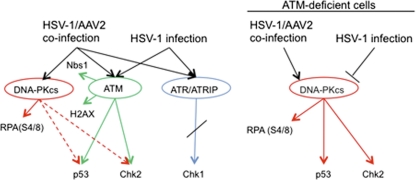Fig 7.
Models of the DDR signaling induced by HSV-1 replication and HSV-1-supported AAV replication. The analysis of the DDRs in ATM-deficient, DNA-PKcs-deficient, and normal cells supports the following models. Infection of cells with HSV-1 induces phosphorylation of ATM and ATR and signaling to their targets Nbs1, H2AX, Chk2, and p53 but not to the ATR target Chk1. In cells infected with HSV-1 alone, DNA-PKcs is rapidly degraded in an HSV-1 ICP0-dependent manner and no DNA-PKcs-mediated signaling occurs. In contrast, coinfection with HSV-1 and AAV2 induces the activation of DNA-PKcs, which enables the phosphorylation of RPA32 at S4/8. Further support for the activation of DNA-PKcs in coinfected cells comes from experiments performed with ATM-deficient cells, as in the absence of ATM, HSV-1 and AAV2 coinfection still induced the phosphorylation of p53, Chk2, and RPA32 at S4/8. In ATM-deficient cells infected with HSV-1 alone, the DDR signaling is broadly reduced, with undetectable levels of Chk2-P-T86 and p53-P-S15 (51, 76).

